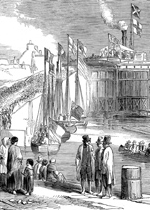Old Galway
Connacht Rugby (28 04 16)

The first team to represent Connacht in rugby played against Leinster on December 8th, 1885. At that time, the game in the west was played by just a few schools. In the city, it was really only UCG and the Grammar School who played with any regularity. By the beginning of the last century the Jes, the Bish and St. Marys were competing. The growth of the game was interrupted by World War 1 and by the War of Independence, but it improved a lot after the truce.
'Shoots' (21 04 16)

Many people will remember “Shoots” as one of the most lovable and delightful characters on the streets of Galway. He was a small man with a big moustache, big glasses and a big personality. His real name was Michael Tuite. He was reared in Artane in Dublin but came to live here at a time when`it was mostly cowboy pictures that were shown in our cinemas Michael was a fan and began to act as if he himself was a cowpoke. Galwegians gradually changed the greeting “Howya Tuite” to “Shoots”, probably with a little help from the man himself.
Geraghty's Man's Shop (14 04 16)

“Good clothes are needed by the men of today and Geraghty & Sons can supply the perfectly tailored suit you need in 4 days. Tailored in our own workshops. Have your clothes made by the men with five generations of Tailoring experience behind them. See our range of suitings, serges and overcoats. 50 shillings, Suit or Overcoat. Customers own materials made up at reduced prices. Special terms for C.M. & T. To the trade. Geraghty & Sons, Lombard St. Galway”.
The Collegiate Church (07 04 16)

The Collegiate Church of St. Nicholas of Myra is the largest medieval parish church in Ireland and its history is a kind of microcosm of the history of Galway. The earliest part of the present churc h dates from the beginning of the 14th century and includes the chancel with its three windows in the south wall. However it is possible that there was an earlier structure on the site. There is a legend that a man from the Aran Islands who died in 1580 aged 220 years could remember a time when the church did not exist but that just sounds a likely story. The records that exist suggest that the church was founded in or about the year 1320.
George Nicolls (31 03 16)

George Nicolls (Seoirse MacNiocall) was born in Dublin but his professional career brought him to Galway town, where he worked as a solicitor and Coroner for the West Riding District of the County. A committed nationalist, he became involved with Sinn Féin in 1907 and also served as President of the County Board of the GAA. Nicolls was the IRB Centre for Galway town. On 31 November 1913, he presided over a meeting in the Town Hall, for the purpose of formally establishing the Irish Volunteers in the county, and subsequently chaired the ‘monster public meeting’ in the Town Hall on 10 December, at which 600 individuals signed up for the Volunteers.
The Galway Volunteers (24 03 16)

Just a few weeks after the Irish Volunteers were formed in Dublin, a meeting was set up in the Town Hall on December 12th, 1913 to establish a Volunteer force in Galway. There was a lot of excitement and expectation as Eoin McNeill, Roger Casement and Pádraic Pearse told the packed hall that their main objective was to win Home Rule but the movement was also formed to protect them from the Ulster Volunteers. The meeting, which was chaired by George Nicholls, was a major success and some 600 men joined up that evening.
St. Patrick's Day Parade 1916 (16 03 16)

This parade started from the Square in the following order:- Eyre Square North – Industrial School Band; Galway Urban District Council; Galway Board of Guardians; Students of UCG; A.O.H. Eyre Square East – The Monastery School Fife and Drum Band; U.I.L.; Town Tenant’s League; Galway Woolen Manufacturing Co., and the Irish National Foresters.
The Eglinton Canal (10 03 2016)

168 years ago this week, on the 8th of March, work started on the cutting of what we know as the Eglinton Canal. There had been previous attempts to open a passage from the river to the sea. As far back as 1498, the then mayor had a plan to connect the Sandy River with Lough Athalia. It was Alexander Nimmo who first mooted the idea of a canal in 1822. If steamboats could travel from the docks to the Corrib, it would greatly enhance the commercial importance of the city and a valuable connection with the hinterland would be established. His original plan was that this connection would start at the top of Woodquay, where McSwiggans is today, go along Eglinton Street and down the west side of Eyre Square to the docks. The cost proved to be prohibitive and there were a lot of objections from people who owned land or a business along the route.
.png)